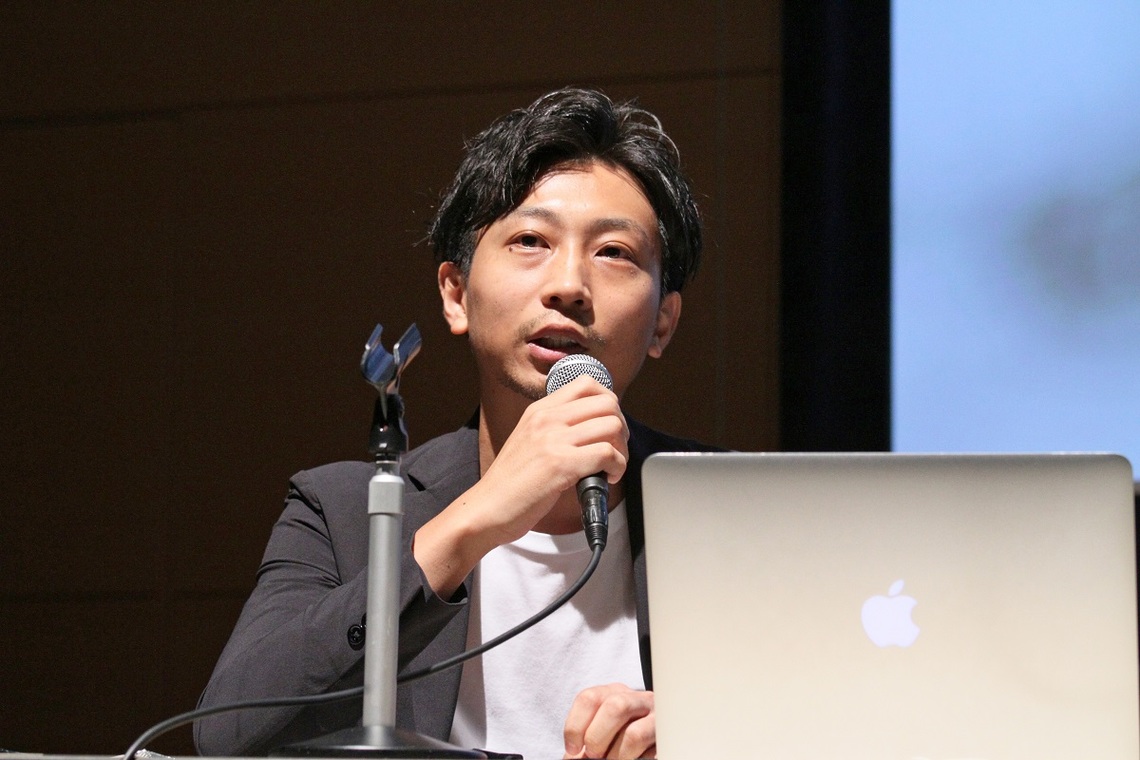In a society where globalization and digitalization advance simultaneously, the power of visuals in business is becoming increasingly important. This Design Talk is a collaborative project between Dentsu Business Design Square's Future Creation Office and Amana, a visual content planning, production, and provider. Specifically, producers and creators from Dentsu Inc. and Amana will explore the essence of "the power of visuals" through an omnibus format covering five themes: "Visuals × Creative PR," "Visuals × New Business," "Visuals × Technology," "Visuals × Internal Activation," and "Visuals × Digital Marketing."
Visual × Creative PR
Koshiba: I'm Takaaki Koshiba from Dentsu Inc.'s Future Creation Office. The theme for this Dentsu Design Talk is "Visual Breakthrough Power!" Visuals are art, messengers that narrate history, and stages that nurture imagination.
Recently, the importance of visuals in business has been recognized for enabling intuitive and efficient communication. Furthermore, they play a vital role in confirming relationships and bonds between people. In this way, visuals exist as an integral part of all our activities.
Kataoka: I'm Keishi Kataoka from Amana. For the past two to three years, I've been focusing on developing businesses that combine Amana's diverse technologies, such as stock photography, CG, and photography. Our company employs over 400 creators and has producers with both expressive power and strong execution capabilities. Today, I'd like to share how we can become a "weapon" to support companies in expanding their business.
Koshiba: Our first theme is "Visuals × Creative PR." We'll hear unique case studies from Kazunori Kawakoshi, Art Director at Dentsu Inc.'s Creative Planning Division 3, and Hayato Satomi, Producer at Amana.

(From left) Kazunori Kawakoshi, Dentsu Inc.; Hayato Satomi, Amana
Kawakoshi: Our first case study is Yahoo! JAPAN's 20th anniversary project, " History of the Internet." This project aimed to visually represent every significant event in the history of the internet, starting from 1969.
We started by researching the events. There were about 1,300 in total, and the volume became enormous, especially after 1995 when the internet exploded. We plotted all these events and visualized them.
Mr. Satomi from Amana joined us from the planning stage. We worked directly with the client and progressed over a long period of time. The production period took about one year.
Satomi: We handled the research phase for the events ourselves, didn't we?
Kawasoko: That's right. We commissioned experts for supervision, meticulously categorizing everything to a level suitable for a history textbook. It was a major undertaking, taking half a year to visualize it all. We drew illustrations, photographed them, retouched the photos, and then combined them. It was incredibly labor-intensive.
Ultimately, we compiled it into a massive 18-meter-long exhibit and a website. The website features a mechanism where clicking on each event displays an explanatory text.
Satomi: The attention to detail in what's displayed makes you want to keep exploring.
Kawasoko: "History of the Internet" won a Gold Award at the New York ADC Awards. The second case study is our collaboration with Hokkoku Shimbun. For a PR campaign to promote the National High School Sumo Tournament held in Kanazawa City, we created a video and graphics titled " Sumo Girls 82 Techniques." This project featured two female sumo supporters recreating all 82 sumo techniques.
Because the newspaper company was the client, having both print and video content made a huge difference in the campaign's reach. In fact, it was featured on numerous TV programs.
Casting the "Sumo Girls" proved challenging for this project. After multiple auditions, we finally found two women with judo dan ranks. These two performed over 500 sumo stances.
Koshiba: When you first heard the idea from Mr. Kawagoshi, didn't you think to yourself, "Are you kidding me?"
Satomi: Honestly, I thought, "Seriously?" (laughs). But as a producer, when someone passionately says they want to do something fun, it gets me excited.
Kawagoshi: I could ask you because I trust you. It's crucial to guarantee visual quality and output while maximizing performance within a limited budget. Going forward, I'd like to try virtual projects that leap off the flat surface using CG or AR.
Visuals × New Ventures
Koshiba: Our next theme is "Visuals × New Business." We'll hear from Mr. Keishi Kataoka, Visual Consulting Supervisor at Amana.

Amana: Mr. Keishi Kataoka
Kataoka: Currently, many new business divisions at major corporations and venture companies face challenges in communicating information to consumers. Because they are confident in their own businesses, communication tends to become one-sided, and they struggle to effectively convey their strengths. What I'm about to introduce are examples where we solved these challenges through visuals.
First, our collaboration with JAXA (Japan Aerospace Exploration Agency). As you know, JAXA possesses remarkable technology. However, most people likely think, "Space technology has nothing to do with us." We worked together to figure out how to plot that technology onto the civilian market.
For example, imagine an idea emerged to create a car that would never crash using JAXA's satellite data. However, trying to share this concept verbally would be difficult because people's mental images vary widely, making it hard to establish a shared understanding. This is precisely why visualization became essential.
Another example involves JAXA's numerical data on the Kuroshio Current. Without specialized knowledge, we couldn't understand it. But mapping the currents and turning them into video made it clear and comprehensible. This is the technology of "data visualization."
SoundFun, a venture company, developed the "Mirai Speaker," which produces sound that is easier for the hearing impaired to hear. However, the technical basis for why the sound carries clearly over long distances was difficult to communicate, often leading to misunderstandings. So, they created a video summarizing the key points of how the Mirai Speaker transmits sound. This helped people understand the core technology, "Curved Surface Sound."
Koshiba: The key takeaway here is that "visualizing the unknown creates a powerful common language." By establishing a visual representation of a technology that people interpret differently, you can unify understanding and spark interest.
Visuals × Technology
Koshiba: Our next theme is "Visuals × Technology." We'll hear about the latest VR case studies from Hikaru Adachi, Head of Dentsu Group's cross-organizational unit " Dentsu VR Plus," and Takashi Okamoto, Executive Officer of the Amana VR Contents Team.

(From left) Dentsu Inc. Hikaru Adachi, Amana: Takashi Okamoto
Adachi: The current VR landscape sees participation from numerous companies like Google, Facebook, Amazon, Apple, and Microsoft. For example, Facebook offers a beta version of its "Spaces" application as a communication enhancement tool. This app allows you to talk with friends in different locations as if they were right in front of you, or even move around places together.
This represents the first step toward "MR" (Mixed Reality), which combines AR and VR and is gaining attention as the next frontier in VR. MR is no longer a distant future concept. It is predicted to become practical within the next three years.
Okamoto: By combining Amana's expertise in photography and CG with our business resources like stock photos and expressive capabilities, we can create VR content that delivers new "experiences."
At the "JAPAN SENSES" event at Isetan Shinjuku, we also let visitors experience Yakushima Island inside the store through VR. This was an attempt to connect realistic VR experiences with product sales. Despite limited production time and budget, we achieved low-cost, short-term production by using VR stock footage we started handling at amanaimages.
I'd also like to share another example using "real-time rendering." This technology, powered by CG, allows users to freely navigate a space themselves. It enables experiences like seeing behind objects, shifting from passive video viewing to active, interactive engagement.
For example, previously at car dealerships, customers would customize grades, colors, and options while looking at catalogs or web browsers. With "real-time rendering," however, they can experience their ideal car at actual size within the CG environment. This is how we can connect the experience directly to purchasing.
Adachi: So you can even experience driving the car while still in the showroom, right?
Okamoto: Yes. Using a controller, you can not only experience driving but also physically grasp and throw objects. Additionally, it enables experiencing non-existent worlds like futuristic settings, as well as simulating homes and interiors.
Currently, beyond advertising and promotions, it's being used for safety training at construction sites and for training new employees. It's a technology with tremendous potential, so I expect we'll see even more diverse applications emerge in the future.
Adachi: Looking ahead to 2020, there's a movement to propose new ways of watching sports. KDDI's free viewpoint technology lets you watch sports as if you were on the field yourself. Anticipating this era, we're considering building a platform together with Amana to house VR materials and content.
Koshiba: Personally, I used to think of VR as something far in the future, but hearing you talk about it has made it feel much more relevant to me.
Adachi: I think the current situation resembles the early days of smartphones. When they first launched, many people wondered, "What's it for?" Yet they became ubiquitous tools before we knew it. VR will likely permeate daily life just as quickly.
*Continued in Part 2
You can also read the interview here on AdTie!
Planning & Production: Dentsu Live Inc. Design & Technical Unit Campaign Planning Room Digital & Account Planning Department Aki Kanahara






























